Text
Most people who have been at the coast have seen barnacles but very few people know much about them.
Well, let’s start off simple. Barnacles are crustaceans and are related to shrimp and crabs. Yeah, that’s right. Kind of hard to tell at a glance. They are very common and latch onto anything stationary and that is because they are sessile, which means they lack the ability to move themselves. Those shells they live in are actually attached with a cement gland that the barnacles have. Yes, literal, natural cement.
You know those little feelers that they stick out to eat? Well those are actually its legs that it uses to filter feed. These are called cirri and can actually help with its ‘breathing’. As they are filter feeders they generally tend to have a diet consisting of plankton and other microscopic organic materials.

When someone says barnacle, people usually think of the small rock-like acne on rocks and ships and while those are barnacles and certainly the most common, known as acorn barnacles.

However there are literally around a thousand species of barnacles. Such as the goose barnacle which have a long stalk.

These are actually edible and widely consumed, considered a delicacy in places such as Portugal and Spain known as percebes

It is also eaten in other places, like Morocco and historically consumed by the indigenous people of California.
While we are on goose barnacles, there was a historic misconception regarding these crustaceans and geese. This was when people did not know that birds migrated and thus had never seen them nest in Europe. It was actually believed that goose barnacles were the eggs or young of geese and that full grown geese would emerge from them. This is generally a medieval era idea and is attributed to the christian church.

Most barnacles, with few exceptions (the goose barnacle is actually an exception), are hermaphroditic, meaning they do if fact contain both sexual organs. Now if you will recall, barnacles are sessile and cannot move. As such, this does make sexual reproduction difficult. To combat this, barnacles have evolved in the most hilarious way.
Barnacles have extraordinarily long penises.
Barnacles actually have the largest penis to body size ratio in the entirety of the animal kingdom.
No I’m not joking.

Behold.
Anyways we’ve discussed that barnacles can only like to situate themselves on stationary or slow moving objects, like rocks or turtles. Well did you know there is a species that actually has chosen to live upon dolphins?
Yep! There is a genus that lives exclusively on the fins of porpoises!
In order to get a good grip though, they ‘bite’ into the skin and dig in to hold on leaving a star shaped scar when they die and fall off.



This next section is going to cover parasitism so just to make sure everyone is comfortable the paragraphs and pictures will be censored. Please look at your own discretion.
Did you know that barnacles can be parasites? Neither did I until yesterday. It’s true and there are quite a few that have taken to this life style. Rhizocephala is a parasitic barnacle that goes after its cousins, mainly crabs and lobsters. When a larva finds a female crab, it will pierce the crab’s egg sac with a needle-like appendage inject a clump of cells. Now that this has happened, the crabs fate is sealed. It will grow inside the crabs body, wrapping around its organs, muscles, and even eyes. It will continue growing to the point it will bulge out of the egg sac, changing the crab eggs to its own eggs. Another barnacle will come along, fertilize the eggs, and then the crab will climb atop a rock and release the larva, letting the process happen again. This barnacles anatomy has deviated to this very specific lifestyle that it in comparison to other barnacles it is almost unrecognizable.


But perhaps that wasn’t interesting enough for you. Well that’s fine because I have another one. This one has chosen its host to be that of the dogfish, a species of small, deep sea sharks. Most barnacles that hitch a ride generally do not harm the host but this one is an exception. This barnacle does not have a shell and thus will dig itself into the dogfish and take refuge under the skin, in the eyes, the spiracles, and mouth. Sometimes even in the sexual organs, effectively castrating the shark. It has roots that will anchor surprisingly deep into the dogfish and sap the nutrients from the surrounding tissue.
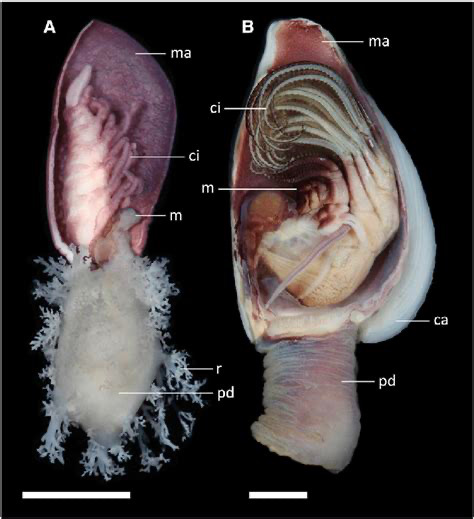
Anelasma squalicola anatomy vs a goose barnacle


September 2, 2022
Sources lost
#fish#fun facts#interesting facts#marine biology#marine life#sea creatures#fishes#animal facts#random facts#miscellaneous facts
10 notes
·
View notes
Text
A quick little talk before we get into the really niche wacky stuff, lets make the distinction of poison and venom.
Don't worry this is going somewhere.
Poison is passive and is transferred through ingestion or absorption, usually through contact (think poison dart frogs who’s poison lies in their skin). Venom on the other hand must be actively injected (think spiders and snakes).
But for your present we are talking about the goopy go getters of the ocean, jelly(not)fish
for those who dont know (which is probably everyone who sees this) the way jellies sting you is through a kind of cell called a cnidoblast or cnidocyte. they work a lot like a pressurized harpoon that launches on contact into prey or in self defense.



this isnt just limited to jellies by the way, they are made up of all creatures in the Cnidaria phylum (like sea anemones and corals), whos defining characteristic is having these cnidoblasts.

Now its not time for any old jello, we are going specific today as a little extra treat. But before we do that I got to tease you a little more, no i'm not cock blocking you its called building suspense.
first we have to talk about a little ol thing thats used for testing the level of toxicity. The LD50 system. This stands for Lethal Dose 50, which means that the number next to it will be the amount that it takes to kill half (aka 50%) of the test animals it was used on. It usually is represented by the amount of venom, poison, or other chemical given for every 100 grams to 1 kilogram of the test animals bodyweight.

Now I do want to make something clear, this is good for a baseline of how strong something might be but the test animals are usually small mammals like rats, rabbits, hamsters, ya know? So it doesn’t mean that it would have the same response on a human.
Lets play a little game because I’m feeling silly. I’m going to give you a the LD50 amount of a coral snake and I want you to guess if it is higher or lower than the secret creature that we are going to talk about.
The LD50 of a coral snake is 1.3. High or low?
The LD50 of this creature is 0.04. yeah thats pretty potent. Way more potent. And our final unlockable character is……. The box jellyfish! It also has an apt nickname as the Sea Wasp.
With up to 15 tentacles growing from each corner of the jelly’s bell (or ‘body’, head maybe?) and each single tentacle being able to reach a possible 10 feet or 3 meters in length the box jellyfish wastes nothing in being as deadly and painful and strange as it can be.

Box jellyfish venom is damaging to not only the heart and nervous system but it is also dermonecrotic. Dermo meaning skin and necrotic meaning dead. Dead skin. This means the venom is capable of killing skin cells and underlying tissue which can cause the skin to go black and die while still attached and will result in potential permanent scarring. Most people who get stung at sea actually go into shock or die of heart failure before they even end up reaching the shore.
They can have up to 24 eyes, some of them with corneas and retinas, which allows them to not only detect light, but also see and circumnavigate objects to avoid collisions.
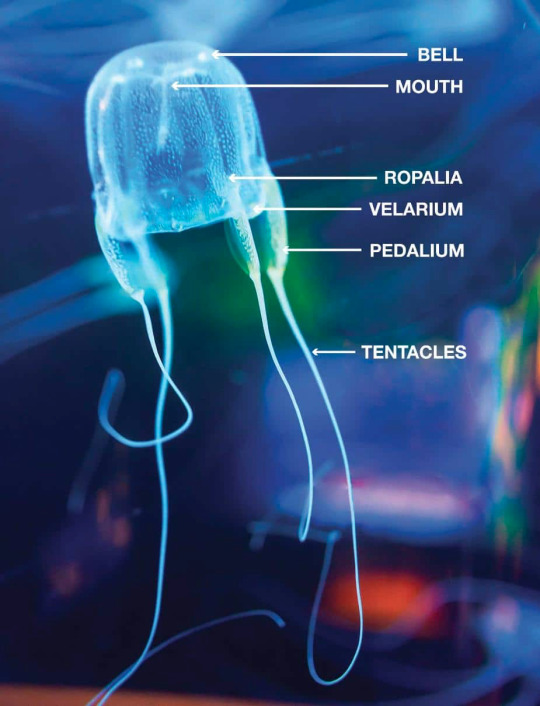
"Box jellyfish leveled up to eyes that are much like our own eyes, complete with a retina, cornea and a lens. The box jellyfish Tripedalia cystophora, has 4 rhopalia, within each of which lie 6 eyes, making a total of 24 eyes! Out of the 6 eyes, two—the upper and the lower lens eyes—have complex structures like our own, while the other 4 are more primitive."" the more detailed [sight] of the box jellyfish, is due to opsins, proteins that can detect light. These opsins are similar to the opsins that allow humans to see the world around them. When light hits these opsins, a series of complex biochemical changes occurs that finally leads to the activation of neurons, which allow the jellyfish to respond appropriately to the light stimulus."

December 25, 20221
Sources lost
2 notes
·
View notes
Text
this is an ocellated Icefish

they primary live along northern Antarctic peninsulas. what makes it remarkable is not the climate it lives in but its blood. All vertebrates have red blood, all except one. this fish has clear blood. this is because it lacks hemoglobin, which is a protein in the blood that carries oxygen throughout the body. the ocellated icefish therefore has white colored organs. presumably oxygen is pumped more easily as the blood becomes thinner without hemoglobin, along with a lack of scales and large organs which make the blood output make up for the lack. the oxygen is supposedly defused into the blood plasma. only one aquarium in the world has a captive specimen, one in japan called the tokyo sea life park.
October 1, 2021
#fish#fun facts#interesting facts#marine biology#marine life#sea creatures#fishes#animal facts#random facts#miscellaneous facts
4 notes
·
View notes
Text
Frogfish are very strange fish, ambush predators of the anglerfish family. Camouflaged to perfection and bewilderment, either covered in algae or having the ability to change color if need be.

They live worldwide, mainly in salty or brackish waters and there are very few places they are not found, such one exception being the Mediterranean Sea.

Frogfish have stocky bodies and upturned mouthes. They lack scales and have a rod at the front of head, just above their mouth. The shape of the bait often takes different shapes such as shrimp or worms. If lost they can regenerate that ‘bait’ called an esca.

The rod will fold back and lie on top of the head for safe keeping.

Frog fish generally sit near coral or at the sea floor and wait for prey to approach, then dangle their esca to lure them. If too far away to notice they use their pectoral and pelvic fins as modified limbs and walk along the sea floor. They barely ever swim and prefer to use these ‘legs’ to clumsily walk over the sand.
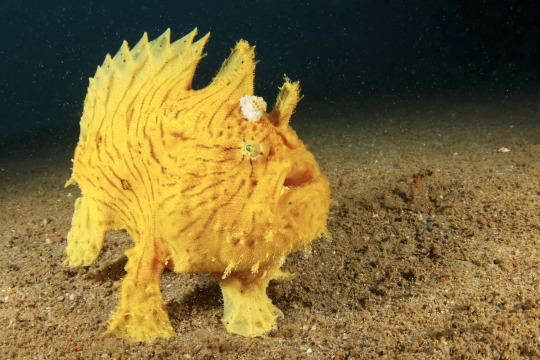
When they do lure in a fish to eat their jaws open up which can enlarge the volume of the mouth up to 12 times and pull the fish in along with water and debris. This attack can be so fast it can only last as much as 6 milliseconds! There is a special latch muscle in their esophagus that keeps the fish from escaping and if their prey happens to be too big, its no matter for their stomach can also expand to allow them to swallow up creatures twice their size.

they can yawn to readjust their jaws
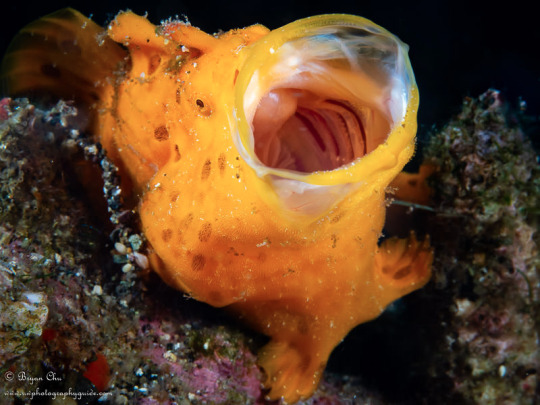
Very little is truly known about them and they can vary drastically in size from species to species, ranging anywhere from 1/8 inch to 22 inches.

a large frogfish next to a sponge

a striated or hairy frogfish

September 17, 2021
#fish#fun facts#interesting facts#marine biology#marine life#sea creatures#fishes#animal facts#random facts#miscellaneous facts
4 notes
·
View notes
Text
theres a deep sea fish called a stoplight loosejaw fish and let me tell you its a wacky one
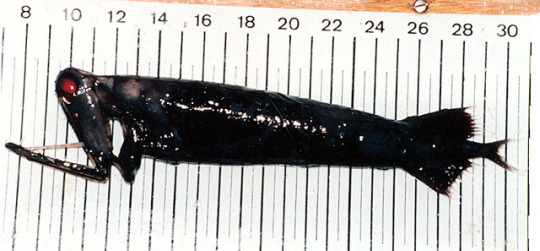
it gets the stoplight part of its name from the bioluminescent spots under its eyes, red and green accordingly
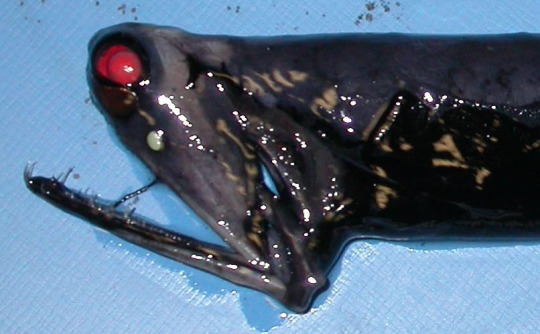
and the loosejaw because its jaw just,, does this

it can dislocate and extend then snap like a mousetrap
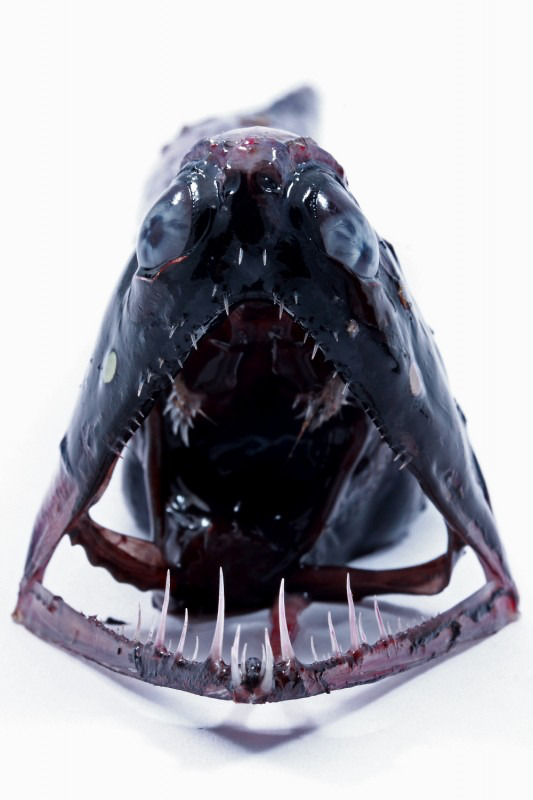
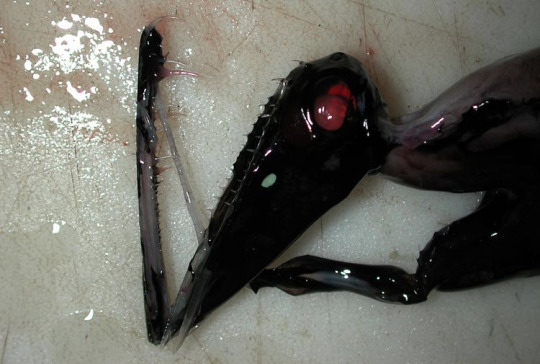
it lives pretty deep, 1700 to 13,000 feet (500-4000 m). due to how deep they live no specimens have actually been intentionally captured, they were all bycatches brought up from deep sea nets
theyre also pretty small with adult stoplight loosejaws are less than one foot (30 cm)
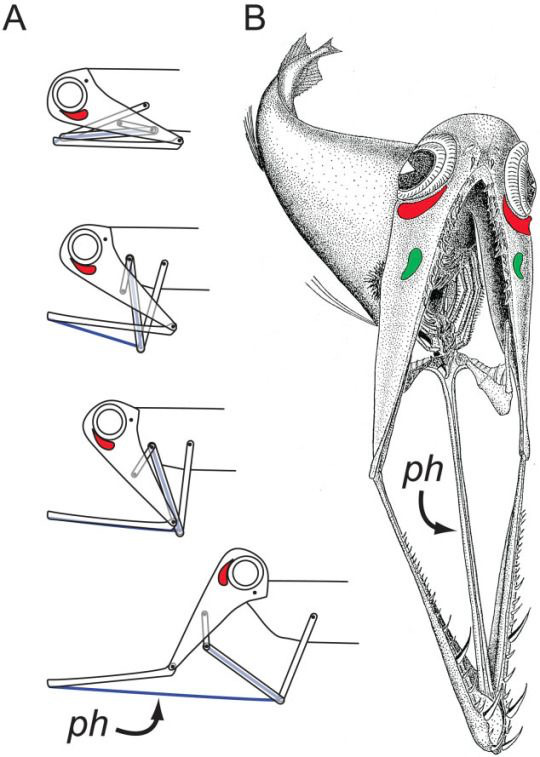
Originally created September 3, 2021
#fish#fun facts#interesting facts#marine biology#marine life#sea creatures#fishes#animal facts#random facts#miscellaneous facts
8 notes
·
View notes
Text
Fish Facts #14 The shark master post
in honor of the shark week i missed last week i guess ill talk about sharks.
sharks and rays give birth to young in pod-like eggs

about 40% of sharks lay these sacks, the others give live birth

sharks teeth can range drastically, from the cookiecutter shark that cuts round holes of flesh out of creatures

to the rows of the eel-like frilled shark

as you may know by know, shark bodies are made from cartilage, the only bones they have are their jaws and teeth, which is why they don't leave behind skeletons.
the reason shark skin feels like sandpaper when you brush your hand along it is because it is made up of millions of extremely small teeth.

they point towards the tail and are meant to reduce drag when the shark swims

sharks are estimated to be very old, residing in our oceans for probably over 400 million years

in fact, they have survived 5 massive planet extinction events, the very same extinction events killed most life on earth and the last one around 65 million yeas ago killed the dinosaurs.
some sharks have barely changed, like the 7 gill shark who can be found 190 million years ago
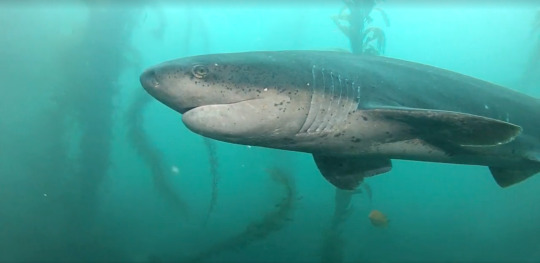
sharks are important predators for the ecosystem, for example they keep sea turtles in check from eating too much sea grass on the Australian coast
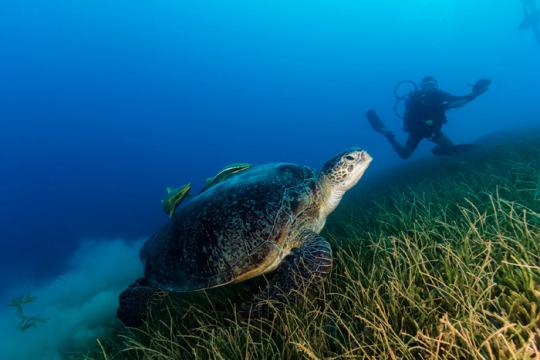
the heavy set bullshark can traverse both salt and fresh water with no problem
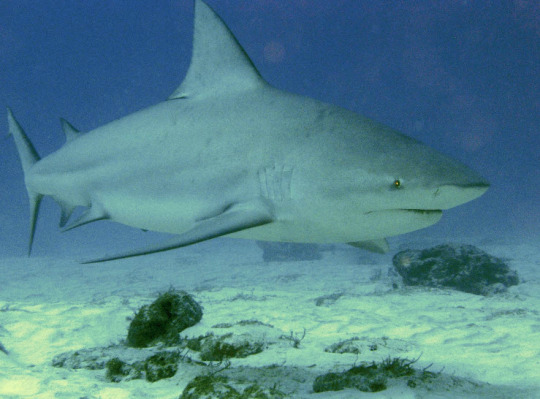
this may seem a little on the nose for some but sharks dont harbor aggression towards humans and wont intentionally attack unless provoked, most incidents are simply mistakes and much prefer to eat their natural prey. in fact 90% of shark attacks are non fatal, once the shark realizes its bitten into a human it usually loses interest and leaves to look for something it would actually like to eat
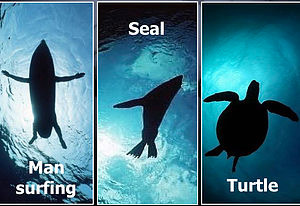
the reason shark teeth are everywhere is because they are constantly growing and being shed
sharks actually do have ears and can hear
sharks dont have gill covers and require the act of swimming to run the water through them and keep them oxygenated, for some if they stop swimming they will suffocate
sharks can actually develop cancer, for a while it was thought they were immune to it

goblin sharks have rarely been observed and there are very sparse recordings of them, they remain one of the most mysterious swimmers

this is an american pocket shark which is very small and can glow in the dark (probably through bioluminescence)


if sharks eat something they cannot digest they can vomit out their stomach projecting whatever cans they might have eaten and them suck it back in
Originally created July 23, 2021
Sources lost
#fish#fun facts#interesting facts#marine biology#marine life#sea creatures#fishes#animal facts#random facts#miscellaneous facts
5 notes
·
View notes
Text
Fish Facts #13 The Arapaima
If a battering ram was a fish, we would have an arapaima. A missile of pure muscle.
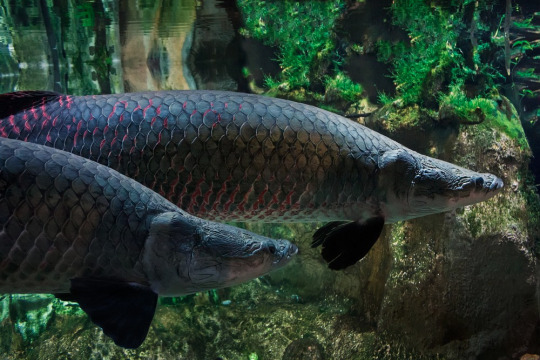
Known locally by pirarucu* or paiche, the arapaima are native to Brazil, Peru, and Guyana but have been introduced in places such as Malaysia, Thailand, Cuba, China, the Philippines, and Singapore. They mainly live in the floodplains off of the amazon river in slower moving water.
(*Pirarucu is a word that comes from the Tupi language, spoken by the indigenous peoples of Brazil that roughly translates to “red fish”, referring to their vivid tails.)


The remote flooded lakes and swamps in which the arapaima lives in contain more dead vegetation than alive, causing the oxygen levels to be very low. Surprisingly, this does not mean anything to the arapaima as they breathe air! It’s gills have become so small that it simply uses its modified swim bladder as a lung and uses the air for its oxygen. Because of this it can only stay submerged underwater for 10-20 minutes at a time however it can survive for an entire day on land!

Arapaima eat mostly fish but have been known to eat fruits, seeds, insects, and even some birds and mammals that can be found on the surface!

In order to eat the arapaima has implemented the ‘gulper’ feeing strategy, by opening their mouths quickly they essentially vacuum and suck in whatever is in front of them. They also can attack with bursts of speed to knock into potential prey, stunning it or hitting it out of the water. They have a bone in their tongue which keeps a tight grip on its food which it can also press up against the teeth they have on the top of their mouths, their palates. Arapaima can be picky eaters and can hold onto their food for several minutes before spitting it out.

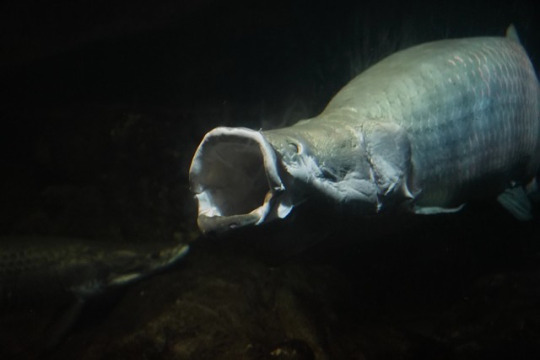
Arapaima are considered one of the largest freshwater fish, maxing at 450 cm (about 14.8 feet) and 200.0 kg (about 440 lbs) but usually generally average around sizes of 200 pounds (90.7 kilograms) and 7 to 8 feet (2.2 to 2.4 meters).

Arapaima are long and slender, covered black scales with a lightish underbelly. They have a dorsal fin that runs along the backside of their body, the end of their tail is covered in thick red scales. They have broad and bony heads that are a greenish copper in color, with mouths that are upturned.
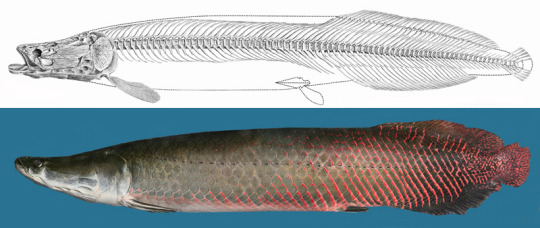
Arapaima breeding happens at the same time as flooding and dry seasons. During a drought a female arapaima will dig a dest with a mate, this nest is about 20 inches wide by 8 inches deep and is dug into the soft mud. There, the female deposits up to 50,000 eggs, which the male then fertilizes.

When the young are born, the male arapaima raises them in his mouth. The arapaima fry are a dark color, so the male’s head turns dark to disguise and camouflage them. In order to keep them close, the maile arapaima releases a pheromone from his head that attracts the offspring and keeps them close. Meanwhile, the female swims nearby and guards the young against predators.
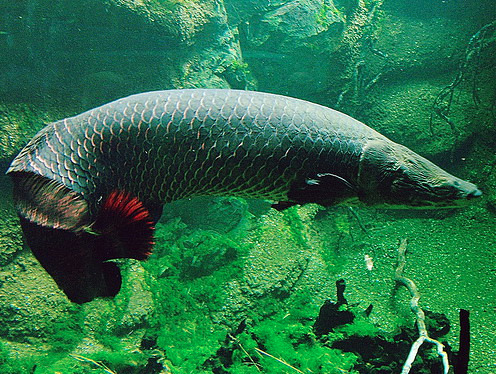
Because the eggs are laid in the dry season, the offspring hatch and are able to flourish during the floodwaters of the rainy season. Both parents help aerate the water for them, as young arapaima still breathe will gills. These gills slowly cease to function as they age.
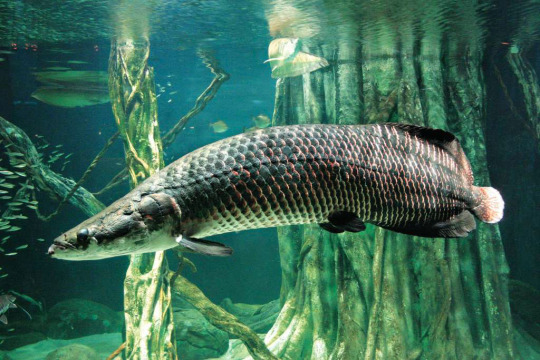
Originally created July 9, 2021
Sources lost
5 notes
·
View notes
Text
Fish facts #12 The Sturgeon
There are 29 species of sturgeon, although most are critically endangered.
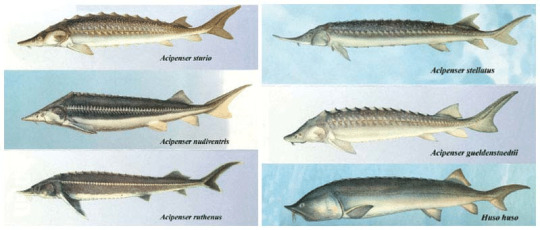
They are related to the paddlefish and are very old fish.
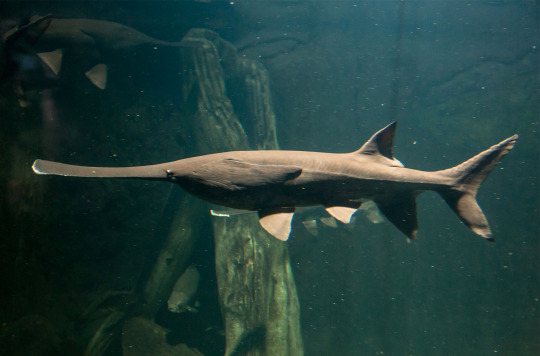
So old in fact that fossils of sturgeons have been found dating all the way back to the Middle Jurrasic, about 174 million to 163.5 million years ago.

They evolved from a group of fish called the palaeonisciforms.
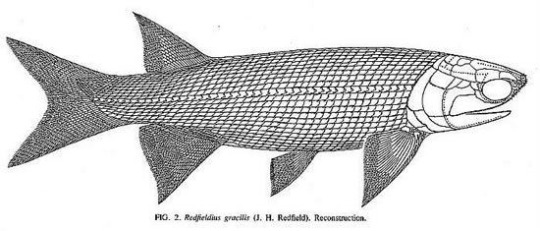
Sturgeons Mostly live in the temperate waters of the northern hemisphere, spending their time in the ocean and them swimming upriver to spawn in spring or summer but some species spend their whole lives in fresh water.
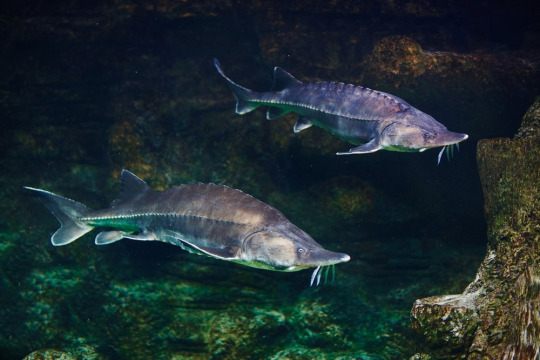
Several species of Sturgeons provide highly sought after caviar from their eggs which can be very expensive.

All Sturgeons have rows bony plates called scutes covering their head and body.

A very strange fact about the sturgeon is that, although it is classified as a bony fish rather than a cartilaginous one (like sharks who have no skeletons), they lack true bone. Most of their internal skeleton structure is made of cartilage. The bone is mostly found on the plates around the head, the spines in its pectoral fines, and exoskeleton like scutes.
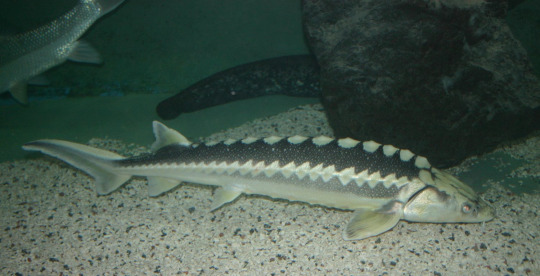
Interestingly enough, sturgeons don’t have teeth but do have barbels that are commonly seen on bottomfeeders like catfish.

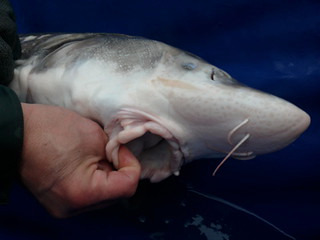
Sturgeons mostly live in the temperate waters of the northern hemisphere, and can be found in the rivers of southern Russia and Ukraine as well as in the fresh waters of North America, although they have been found in some parts of China as well. They spend most their time in the ocean and them swimming upriver to spawn in spring or summer but some species spend their whole lives in fresh water.

The young grow very rapidly after being hatched until they hit maturity, after which they continue to grow for several years but at a much slower pace.

Sturgeons can become giants if left to alone, specimens of 2–3 metres (7–10 feet) a common occurrence in some species!

The largest recorded catch was a female measuring at 7.2 meters (24 feet) and weighing 1,571 kg (3,463 lb)!! This was in 1827 and the hunting of sturgeons has made it a lot harder for them to live their full life spans and reach max growth.

(this isn't the same fish but its the same species, a beluga, and its from 1922)


this one got in the Guinness Book of world records for its size
Originally created July 2, 2021
Sources lost
#fish#fun facts#interesting facts#marine biology#marine life#sea creatures#fishes#animal facts#random facts#miscellaneous facts
4 notes
·
View notes
Text
Fish Facts #11 Catfish
Catfish are a very diverse group of critters, living all across the globe, in costal waters and inland (that means both salt and fresh water) and in every single continent minus Antartica!
Catfish are generally bottom feeders, evident by there whiskers which is where they get the cat in there name from. Those whiskers are actually called barbels but some catfish don’t even have them! They also have downward facing mouths, consuming whatever might lurk in the mud like larvae for younger fish and plants, crawfish and snails for some adults. However they can become carnivores, swallowing some fish whole.

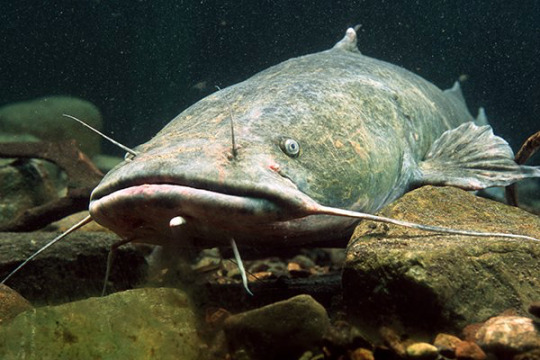
Most catfish don’t have scales and instead are very slimy leathery skin, and they don’t have skin for a particular reason, they are simply built different.

However there is a catfish that has armor, the aptly named armored catfish. It is covered in triangular bony plates and are one of the few catfish that use there eyes rather then relying on sense of smell.
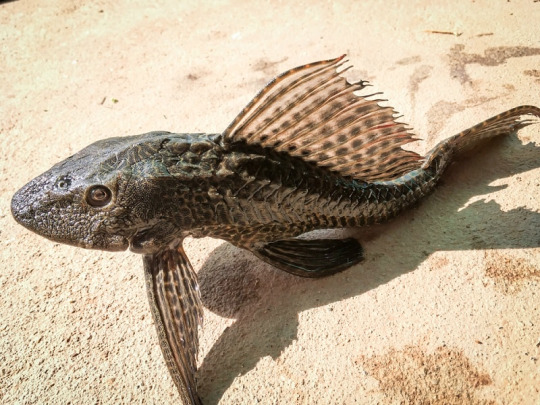

Catfish drastically differ in sizes, such as the small Bristlenose Pleco often kept in aquariums to feed on algae which only reaches about 5 inches (12.7 cm) at maturity,
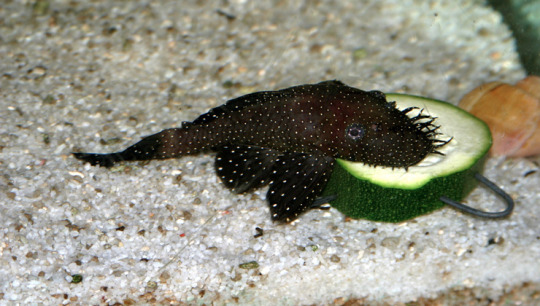
to the gigantic Mekong catfish which can get up to a record 9 ft (2.7 m) and weighed at 646 lbs (293 kg)!!
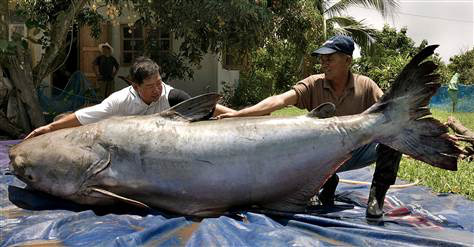
catfish also make a sort of growling sound out of water, a sound produced by the air going through its gills
Originally created June 25, 2021
Sources lost
#fish#fun facts#interesting facts#marine biology#marine life#sea creatures#fishes#animal facts#random facts#miscellaneous facts
2 notes
·
View notes
Text
Fish Facts #10 Deep Sea Chimaera
In Greek mythology the Chimaera was a monstrous fire breathing hybrid of a lion, a goat, and a snake for a tail. However the real Chimaera might seem even more strange to some. Some alternative names you might know them by are ghost sharks, ratfish, or rabbitfish.
The chimaera are primarily deep sea fish who’s body lacks a skeleton but is made up of cartilage, similar to sharks, they have been found in waters around 1,000 feet (305 meters).

Instead of having pointed teeth it has 3 pairs of crushing plates similar to a ray’s and the general shape of it’s body reminding people of a shark, those animals being its closest living relatives.

For an adult chimaera its size can vary from 60 cm (2 feet) to 200 cm (6.5 feet), fairly small compared to most other deep sea creatures.

Those peculiar dots on its face are sensory organs which a large majority of fish have and are scaleless.

Although their gills are not visible, they do have them! The four gills are hidden by a sort of flesh curtain called a Operculum. The holocephalans are the only group of fish that possess true nostrils. Respiratory water is drawn in through the “nostrils” and passed over the gill arches.

They also swim primarily with their large side pectoral fins instead of their tail like sharks do, making them akin to ocean birds.

These fish belong to subclass Holocephali, which is over 420 million years old but despite being that old there are more than 50 species living today. Also here is a wacky tidbit, Holocephali translates to whole head in latin!

The exposed mouth of a plough-nose chimaera, which ses its snout to probe the sediment in search of food. It's nostrils are also visible in this image.
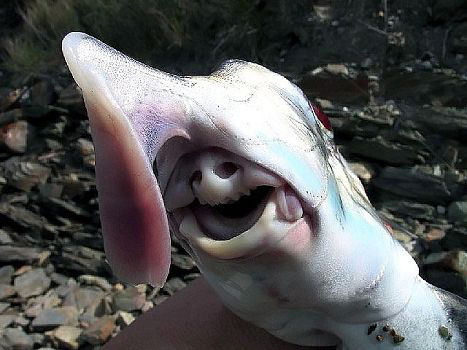
They also a carry toxic spine in front of their first dorsal fin to protect from any attacks. Although definitive proof of spine toxicity is lacking in the literature, medical reports suggest fishermen have experienced burning and numbing sensations for weeks after puncture traumas from chimaera spines. (I did find a couple medical journal pertaining to the injuries, please let me know if you would like to read it and I will be glad to share!)

youtube
youtube
youtube
#fish#fun facts#interesting facts#marine biology#marine life#sea creatures#fishes#animal facts#random facts#miscellaneous facts#Youtube
1 note
·
View note
Text
Fish facts #9 Saw Fish
What if you put a chainsaw on a ray? This is presumably the question that nature asked when it created the sawfish, an endangered and bizarre creation.
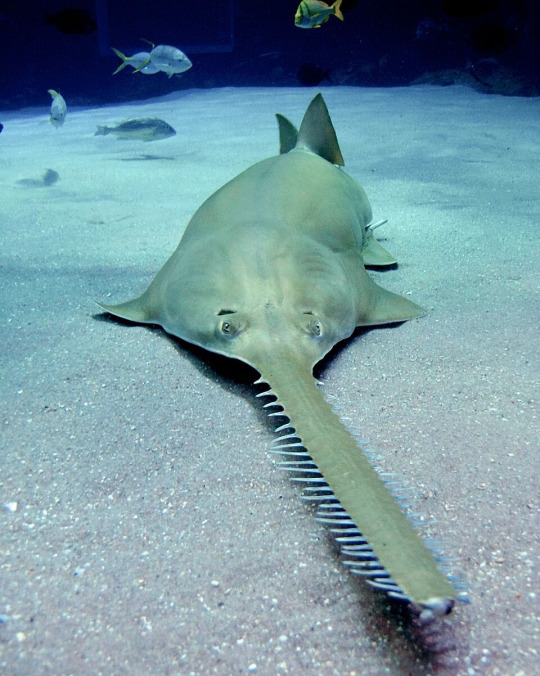
These gigantic shark-like fish have a long protruding snout, known as a rostrum, the edge lined with sharp teeth. Used as a defense mechanism it can swing back and forth to protect from predators, stun and slice prey, and dig through sediment. Sawfish can grow huge, smalltooth species averaging at 18 feet (5.5 meters) whilst the largetooth can reach up to 23 feet (7 meters) and can live for 25–30 years.
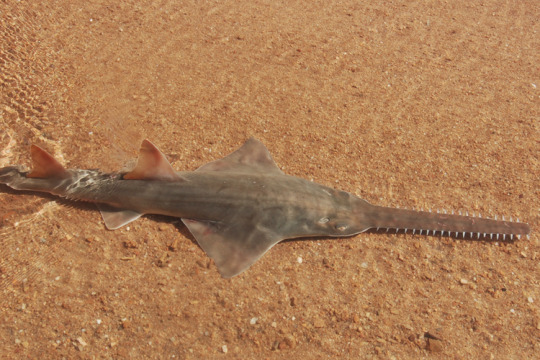
Interestingly enough the teeth on it’s snout are not true, real teeth like ours but instead are a kind of modified scale.

Like most species of sharks, these rays give live birth.

Due to their large size and snout, sawfish can easily become caught in nets and fishing line, and live worldwide, across the coasts of the U.S., Africa, the Indian Ocean, Australia, and even China, and Japan. Sawfish prefer costal waters but can swim into freshwater river systems.

Originally created June 11, 2021
Sources lost
#fish#fun facts#interesting facts#marine biology#marine life#sea creatures#fishes#animal facts#random facts#miscellaneous facts
1 note
·
View note
Text
Fish facts #8 Zappy sea pancake
When thinking of an aquatic creature that is related to electricity, the average person is prone to think of an electric eel but while it is not a common ability it is not exclusive to the electric eel.
The torpedo ray, also known as the electric ray, is obviously a ray. They live by themselves usually in warm, shallow, coastal waters but the subspecies of blind electric rays can live at depths of 1,000 m (3,300 feet). They live world wide and their sizes range from 30 cm (1 foot) to about 2 m (6 feet), although females rays grow larger than their male counterparts.

an image of a common torpedo ray, the marbled electric ray
Now I brought up the electric eel for a good reason when talking about the torpedo ray. They both have electric organs and utilize it in similar ways for hunting. The torpedo ray has two bean kidney shaped organs in their head/body, around the base of the pectoral fins. The shock can get up 220 volts, which is much more impressive than the 45 or higher volts taken to knock a grown adult unconscious. The usually swallow their prey whole, as they lack they jaws for chewing. It is also used to sense the electricity in the environment, as all creatures produce electricity in varying intensities and this allows then to sense their surroundings and potential predators and prey.


Torpedo rays have actually been known to exist for quite a while and ancient greeks and romans actually even used the electric shock of the ray as a sort of numbing agent for operations and even childbirth. Hell, they were even used as treatments for headaches and gout, which is a form of arthritis!!
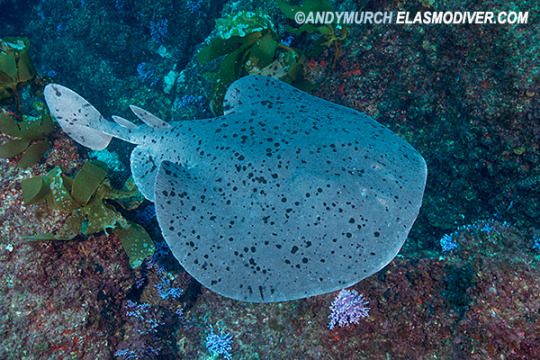
A size comparison for a large version of a torpedo ray being tagged by a diver.

Originally created June 4, 2021
Sources lost
#fish#fun facts#interesting facts#marine biology#marine life#sea creatures#fishes#animal facts#random facts#miscellaneous facts
3 notes
·
View notes
Text
BONUS FACTS:
theres two types of biological sex change in fish. (It's officially called hermaphroditism but I don't know if thats an ok term or not so I'm just not gonna use it)
There is the first one, simultaneous, in which an individual has both working female and male reproductive cells at the same time. This doesn't mean that they are self fertilizing, most cannot, the kilifish is the pretty much the only exception.
The second is sequential, where the fish starts out at one sex and later in life changes to become another, either going from a biological male to biological female, or biological female to biological male! For the most species this change is permanent although there are some types of gobies that can change at will.
#fish#fun facts#interesting facts#marine biology#marine life#sea creatures#fishes#animal facts#random facts#miscellaneous facts
1 note
·
View note
Text
Fish Facts #7 The parrotfish
So, what happens when you combine a parrot and a fish? An abomination.
The parrotfish. No parrot, just fish. A tropical fish, residing in coral reefs.
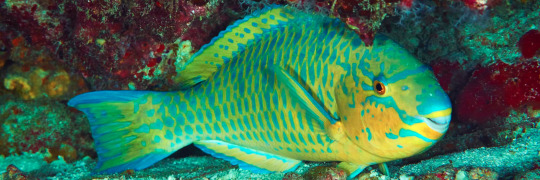
Named after the parrot not only for its bright colors and patterns but also its mouth which has a ‘beak’ made up of tiny teeth, they have even more teeth that go all the way down their throats. These teeth are used for scraping algae off of coral and rocks, sometimes it even eats the coral itself. Their scales are thick and protective to ward of attacks and can even stop a spear.

A closeup of the mouth.
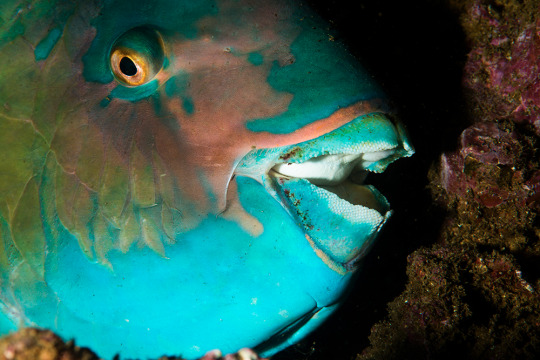
It eats so it must excrete, and that it does. Through its digestive system the bits of coral it has eaten and it ends up as sand, which is uhh defecated, to put it lightly. Scientists estimate that a single parrotfish can produce 2,000 pounds (907 kilograms) of sand a year!
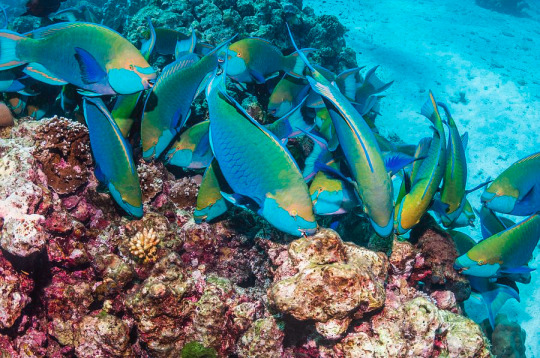
The parrotfish eating algae and seaweed is actually very important for coral reefs, as too much can choke out the coral and cause it to die off which is worsened by climate change and pollution in the ocean.
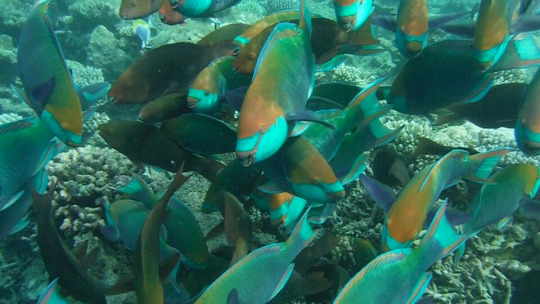
There are lots of species of parrotfish that can be found world wide in tropical and subtropical oceans. They are rather social fish, living in schools of approximately 40 individuals. Parrotfish are also among the fish that can change their sex. They can live for up to 7 years and can grow up to 4 feet (1.2 meters).
Originally Created may 28, 2021
Sources lost
#fish#fun facts#interesting facts#marine biology#marine life#sea creatures#fishes#animal facts#random facts#miscellaneous facts
1 note
·
View note
Text
Fish facts #6 The Betta
The Betta fish. Commonly held as pets in aquariums but how tame are they really?
Well, if their other common name as Siamese Fighting Fish is anything to go by, probably not very mundane companions. They are very territorial and are introverted but can live with other fish given the right circumstances. In fact, during the 1800’s in Thailand, they were collected and bred for fighting, similar to dog fights or cock fights. The current aggression from the Betta is a combination of their natural protectiveness and the hostility that was bred into them.
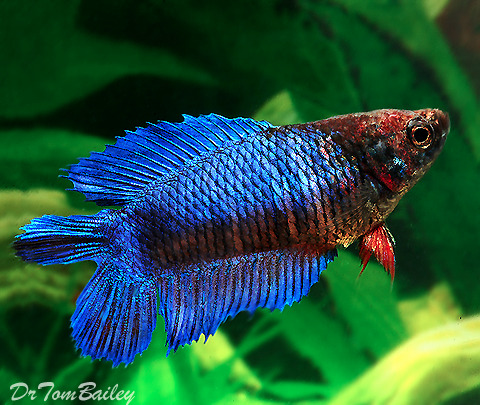
There are many variations of the species but the most common is the Betta Splenden, the one most typically found at pet stores. They are pretty small, chilling at 2.25 inches (5.7cm) and living on average for 2-4 years in domesticity, although they can live more than double that with correct care. Male Betta fish have an unusual quirk, they build nests made of bubbles, presumably to advertise health to a potential female, and if he scores a date the eggs will remain in the bubble nest, protected by the father. They require lots of space in order to remain happy and healthy and are mainly carnivores, although they are omnivores. If the color of the fins are dulled that can indicate sickness and/or stress.

Betta fish are tropical fish, making them colorful and appealing to look at. They come in many colors and their fins and tails have lots of variety in shapes, although males tend to be larger and more ornate than females. This also makes them more prone to warmer, stable waters. Betta’s also tend to enjoy jumping out of the water! They are actually extremely smart, they can recognize different people and can learn.

As mentioned by a factual ally earlier, betta’s can actually breathe in low oxygen water and even out of water with what is known as a labyrinth organ! Their fins, mostly the subject of discussion when it comes to betta’s, contain both nerve cells and taste buds which allow them to taste food nearby. Betta fish aren’t bottom feeders and you can tell that just by looking at their mouth. It is upturned, which means stronger jaws and provides an ability to feed from insects off of the surface of the water with ease.
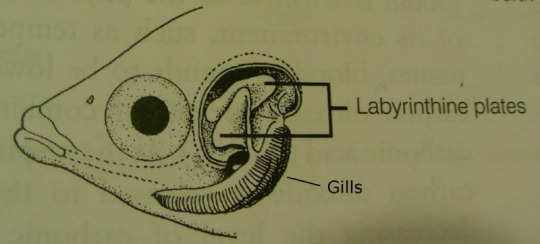
Originally created May 21, 2021
Sources lost
#fish#fun facts#interesting facts#marine biology#marine life#sea creatures#fishes#animal facts#random facts#miscellaneous facts
0 notes
Text
Fish Facts #5 two in one
The specimen I have chosen today is debatably among the strangest I have shown so far, a fairly small fish, with some unusual biology.
The barreleye fish, also lovingly nicknamed the spook fish, is stunningly bizarre and fascinating. Growing to 15 centimeters (6 inches), they reside in mid to deep water oceans including places from the Bering Sea, to Japan, to Baja California at a depth around 600–800 meters (2,000–2,600 feet).
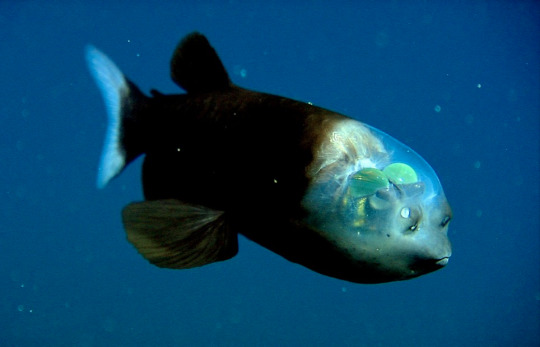
They have a small mouth made for eating zooplankton as well as crustaceans and siphonophores.
BONUS FACTS BONUS FACTS: Siphonophores are extraordinary beings, estranged cousins to corals and sea jellies of all things. They have been noted as some of the longest animals in the worlds, with some specimens getting as long as 40 meters (131.2 feet). The majority of siphonophores are long and thin and are mostly made of a clear gelatinous material. The most colorful of the creatures are the deep water variety, that have dark oranges or red digestive systems that show through the clear tissues. They do have bioluminescence, glowing green or blue when disturbed. They are colonies of many tiny organisms and hunt similar to jellies.
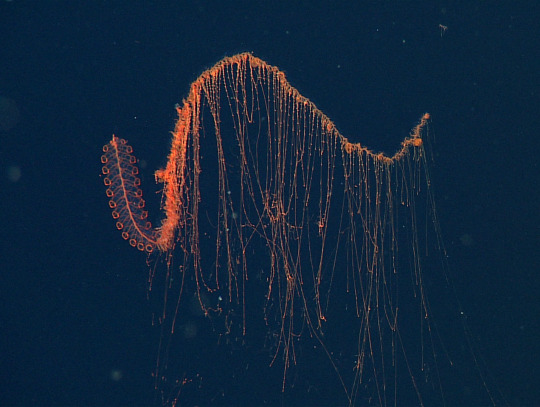
double extra facts: the man o war jelly is a siphonophore
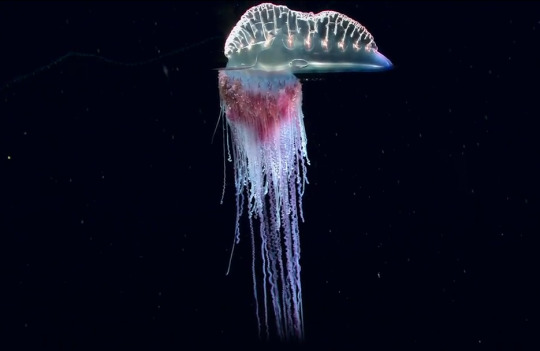
Ok back to our regularly scheduled program.
The crowning feature of the barreleye fish is its eyes and transparent domed head. Above its small mouth it has two grayish orbs that are not its eyes, those are basically the fish’s nose, its olfactory system. Inside it’s glassy head there are two greenish tubular shapes which are its real eyes. They can swivel up, to look directly above it and forward so it can see what it eats. The body is mostly black and have big fins to keep it floating gently in the currents.

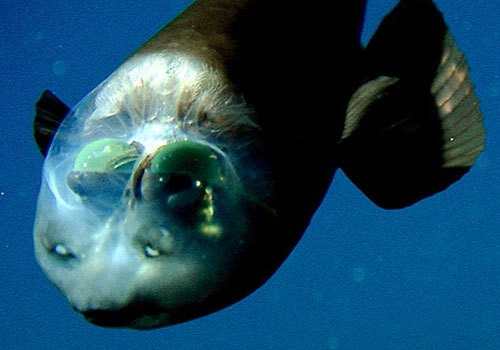
youtube
Originally created May 14, 2021
Sources lost
#fish#fun facts#interesting facts#marine biology#marine life#sea creatures#fishes#animal facts#random facts#miscellaneous facts#Youtube
2 notes
·
View notes
Text
Creatures come and go, they survive or die, and we can all but imagine what those that died were like by just their bones. Many people have theorized what things would be like if dinosaurs had survived but in the end it is just simple thought experiments or fiction.
But what if I told you there was an ancient creature that survived? A fossil that lived millions of years ago and that still lives to this day, a being that was long presumed extinct.
May I introduce you to the Coelacanth.
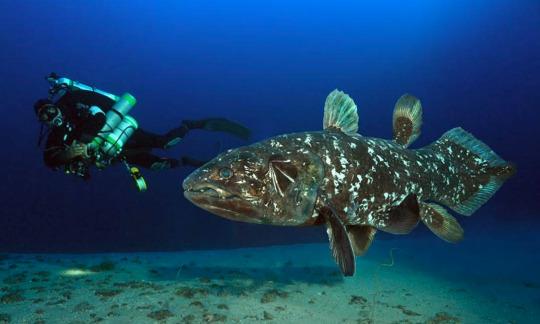
A fish without any living close relatives and despite being a fish is more closely related to lungfish and tetrapods then to common, modern day ray-finned fish.
It has very unique biology, features that are extremely rare in creatures of the modern era or are completely exclusive to the coelacanth. It bears bony, limb-like fins, a “secondary spine” located under its spinal cord that is hollow and filled with a fluid called a notochord which is has been seen in other early vertebrates, a bizarre hinge in the skull that can allow for the top half of the cranium to swing up causing the mouth to enlarge to a gaping size, and finally what is called a rostral organ located in the snout that is part of the electro sensory system.
Now these are all neat but what does this beast look like? Well in size they are around 6.5 feet (1.98 meters) and can weigh 198 pounds (89.8 kg). They have a thick body and a wide head with blackish coloring and white mottled spots along its scales.

They are extremely rare, presumed to have at least 90 subspecies is now only down to two located in the Comoros Islands which is located along side the western Indian Ocean, Madagascar, and the east coast of Africa, some also living in the East African coast and into Indonesian waters. Even though they live in temperate waters, they are still deep sea creatures at heart, living below the continental shelf in what is referred to as the “twilight zone”, generally between 500-800 feet (152-243 m).

For their feeding habits they tend move slowly and tend to feed primarily off of cephalopods and small fish.
They’re old, but how old? Coelacanths appeared about 350 million years ago in the Carboniferous period, with fossils being found at the end of the Permian period (251 million years ago) to even the end of the Jurassic period (145.5 million years ago).
They also tend to hide in "caves" along rock walls to avoid light.

Also when you look at them front on they have a silly little grin.

Originally posted May 7, 2021
Sources lost
#fish#fun facts#interesting facts#marine biology#marine life#sea creatures#fishes#animal facts#random facts#miscellaneous facts
8 notes
·
View notes